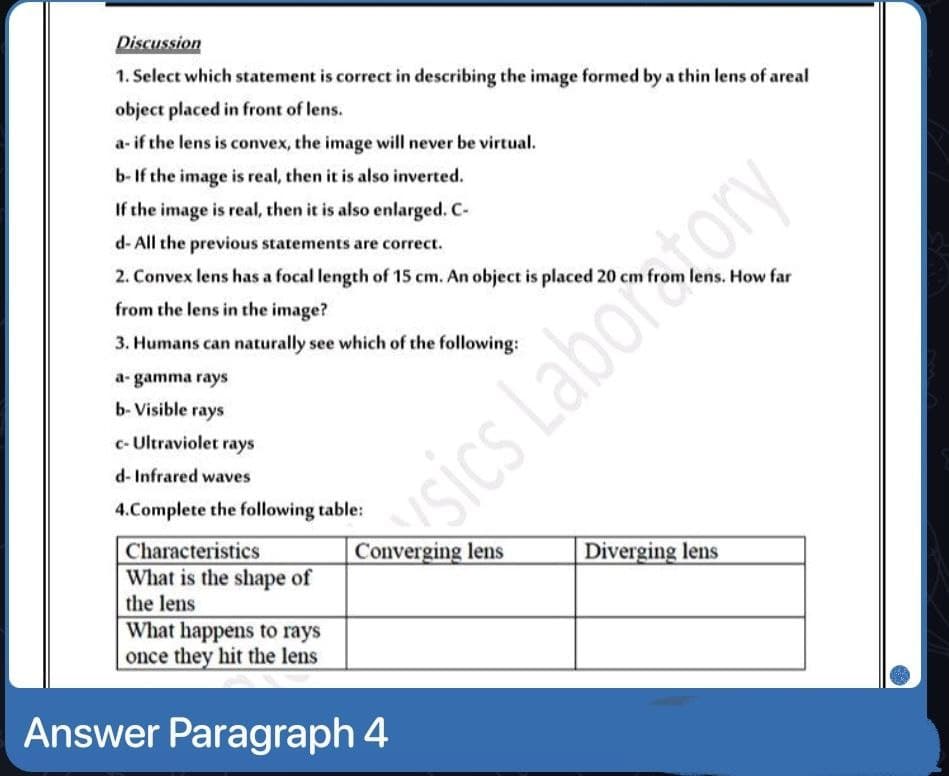Discussion 1. Select which statement is correct in describing the image formed by a thin lens of areal object placed in front of lens. a- if the lens is convex, the image will never be virtual. b- If the image is real, then it is also inverted. If the image is real, then it is also enlarged. C- d- All the previous statements are correct. 2. Convex lens has a focal length of 15 cm. An object is placed 20 cm from lens. How far from the lens in the image? 3. Humans can naturally see which of the following: a- gamma rays b- Visible rays c- Ultraviolet rays d- Infrared waves sics Laborstory 4.Complete the following table: Characteristics What is the shape of Converging lens Diverging lens the lens What happens to rays once they hit the lens
Discussion 1. Select which statement is correct in describing the image formed by a thin lens of areal object placed in front of lens. a- if the lens is convex, the image will never be virtual. b- If the image is real, then it is also inverted. If the image is real, then it is also enlarged. C- d- All the previous statements are correct. 2. Convex lens has a focal length of 15 cm. An object is placed 20 cm from lens. How far from the lens in the image? 3. Humans can naturally see which of the following: a- gamma rays b- Visible rays c- Ultraviolet rays d- Infrared waves sics Laborstory 4.Complete the following table: Characteristics What is the shape of Converging lens Diverging lens the lens What happens to rays once they hit the lens
College Physics
10th Edition
ISBN:9781285737027
Author:Raymond A. Serway, Chris Vuille
Publisher:Raymond A. Serway, Chris Vuille
Chapter25: Optical Instruments
Section: Chapter Questions
Problem 17P
Related questions
Concept explainers
Applications Of Reflection Of Light
When a light ray (termed as the incident ray) hits a surface and bounces back (forms a reflected ray), the process of reflection of light has taken place.
Sign Convention for Mirrors
A mirror is made of glass that is coated with a metal amalgam on one side due to which the light ray incident on the surface undergoes reflection and not refraction.
Question

Transcribed Image Text:Discussion
1. Select which statement is correct in describing the image formed by a thin lens of areal
object placed in front of lens.
a- if the lens is convex, the image will never be virtual.
b- If the image is real, then it is also inverted.
If the image is real, then it is also enlarged. C-
d- All the previous statements are correct.
2. Convex lens has a focal length of 15 cm. An object is placed 20 cm from lens. How far
from the lens in the image?
3. Humans can naturally see which of the following:
a- gamma rays
b- Visible rays
c- Ultraviolet rays
d- Infrared waves
sics Laboratory
4.Complete the following table:
Characteristics
Converging lens
Diverging lens
What is the shape of
the lens
What happens to rays
once they hit the lens
Answer Paragraph 4
Expert Solution
This question has been solved!
Explore an expertly crafted, step-by-step solution for a thorough understanding of key concepts.
This is a popular solution!
Trending now
This is a popular solution!
Step by step
Solved in 2 steps with 4 images

Knowledge Booster
Learn more about
Need a deep-dive on the concept behind this application? Look no further. Learn more about this topic, physics and related others by exploring similar questions and additional content below.Recommended textbooks for you

College Physics
Physics
ISBN:
9781285737027
Author:
Raymond A. Serway, Chris Vuille
Publisher:
Cengage Learning

Principles of Physics: A Calculus-Based Text
Physics
ISBN:
9781133104261
Author:
Raymond A. Serway, John W. Jewett
Publisher:
Cengage Learning

Physics for Scientists and Engineers
Physics
ISBN:
9781337553278
Author:
Raymond A. Serway, John W. Jewett
Publisher:
Cengage Learning

College Physics
Physics
ISBN:
9781285737027
Author:
Raymond A. Serway, Chris Vuille
Publisher:
Cengage Learning

Principles of Physics: A Calculus-Based Text
Physics
ISBN:
9781133104261
Author:
Raymond A. Serway, John W. Jewett
Publisher:
Cengage Learning

Physics for Scientists and Engineers
Physics
ISBN:
9781337553278
Author:
Raymond A. Serway, John W. Jewett
Publisher:
Cengage Learning

Physics for Scientists and Engineers with Modern …
Physics
ISBN:
9781337553292
Author:
Raymond A. Serway, John W. Jewett
Publisher:
Cengage Learning

College Physics
Physics
ISBN:
9781305952300
Author:
Raymond A. Serway, Chris Vuille
Publisher:
Cengage Learning

Physics for Scientists and Engineers, Technology …
Physics
ISBN:
9781305116399
Author:
Raymond A. Serway, John W. Jewett
Publisher:
Cengage Learning